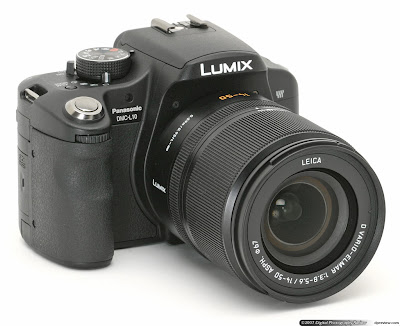Preview based on a pre-production DMC-L10
Eighteen months ago Panasonic's first digital SLR caused quite a stir at an otherwise lackluster PMA 2006, due in now small part to its unique Leica-inspired styling and Vario Elmarit 14-50mm optically stabilized lens. But ultimately the DMC-L1, failed to translate all that launch interest into actual sales. This was thanks in part to its high price (the kit lens accounting for half the $2000 ticket) and rather slender feature set. But the other problem - shared with the Olympus E330 (on which it was based and with which it shared many components) - was that the bulky unconventional styling, dismal viewfinder and clunky Live View Implementation sent potential purchasers scurrying back to the 'safe' choice of an SLR from a more mainstream manufacturer.
And now we have the second Panasonic Lumix DSLR, the DMC-L10, a far more conventional affair (it actually looks a lot like a reflex version of the FZ50) that offers some significant new features including a fully articulating LCD monitor, user interface improvements, a resolution hike to ten megapixels and the ability to use contrast-detect autofocus in Live View mode using the sensor itself (though only with compatible lenses - basically the two new zooms announced today). There are also several features that have migrated from Panasonic's compact Lumix range, including Intelligent ISO mode, quick 'FUNC' menu and a sprinkling of scene modes.
Like the L1 the new model is the fruit of the partnership between Panasonic and Olympus, and once again it features a Live MOS sensor and SSWF dust removal filter, (we don't have definite information yet, but the mirror box and sensor are, we suspect the same as the E-410). Once again the kit lens is a Panasonic/Leica collaboration, complete with optical image stabilization, though (presumably to keep costs down) it is a lighter, slower zoom (F3.8-5.6) and it doesn't have an aperture ring. The L10 also does away with the L1's traditional shutter speed dial in favor of twin control dials.
Simon: we've actually been using the DMC-L10 for a few weeks now and were under the impression we'd be able to post a full 'Beta' gallery today and so I've actually taken several hundred gallery shots. Unfortunately last night Panasonic informed us that we could only post low resolution versions as image quality has not been finalized. Since we have a policy of only providing 'the whole truth' when it comes to image samples we've decided not to publish any sample images until we have a final production camera.
Compared to the DMC-L1, feature and specification differences
The L10 is a very different beast to the camera that came before it, and is obviously aimed at a very different segment of the market. Where the L1 was a solid, heavy lump of a camera with a semi professional build, traditional 'shutter speed and aperture dial' operation and styling that owed more than a nod to Leica's rangefinder models, the L10 is a lightweight, conventionally styled SLR with a control interface and feature set that matches mid-range models from the bigger players in the market. You don't get the L1's tank-like build, and some users will bemoan the loss of the unique 'bounce' 2-position flash and aperture ring, but I think it's safe to say that the L10 is far more likely to lift Panasonic out of its niche position in the DLSR market than the L1 ever could.
The main spec differences (as we know them today) are shown below, but first let's start with a summary of the important stuff:
New lightweight compact body.
Resolution increase (from 7.5 to 10 megapixels).
Slightly brighter viewfinder (with optional 1.2x magnifier eyepiece included) .
Articulating screen (180° swing and tilt).
New smaller, lighter kit lens (around a stop slower max aperture too).
All-new control interface.
Contrast detect autofocus in live view (mirror stays up) - with compatible lens
Less expensive than L1 at launch (though recent L1 price drops may reduce gap in store).
specification
Tuesday, November 6, 2007
Preview: DMC-L10
Subscribe to:
Post Comments (Atom)
No comments:
Post a Comment